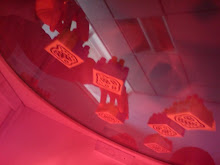Two things MUST be taking into accord when thinking about lighting
- To track the objects the table needs to be is well illuminated. Allowing the camera and ReacTIVision to see the markers clearly.
- The glass screen must be dark enough so that the user can see the projected visual aid.
So I ask myself this question.....
How can I have a dark surface and illuminate the table at the same time?
Sound impossible?
All light from the visable specrum must be filtered through the camera, so that the projector image does not interfere with the tracking of the markers.
As infrared light is just below the visible spectrum in frequency, an IR lamp can be used to illuminate the table so that the markers can be seen by the camera.
IR lamps on ebay.co.uk go from about £20. I need to know the exact distance between the camera and the marker objects to know exactly how many LED IR's I need in order to get enough light. There is a shop on ebay that sells IR lamps, I will email the owner and see if I can get any further information on this.
If I am using Inferred light then I must think about how I will filter out all other visible light. The light from the projection will interfere with the camera. A filter can be used to do this, but I have found an alternative method.
The PS3 eye toy which I have decided to use in this project has a IR blocking lense inside the sencer. I aim to take the camera apart and initially remove the IR blocking lense from the web cam.
below is a very helpfull video tutorial on how to do this:
part 2
The video tells me I can use an old floppy disc as a visible light blocking filter.
After watching this tutorial I decided to take my eye toy and have a go............

















